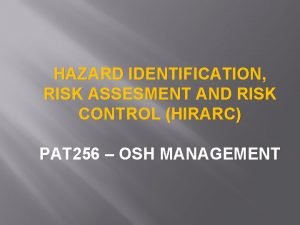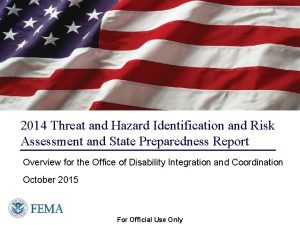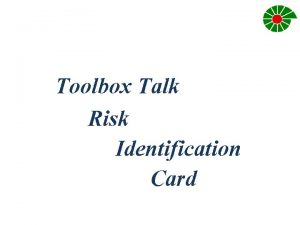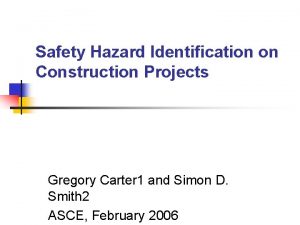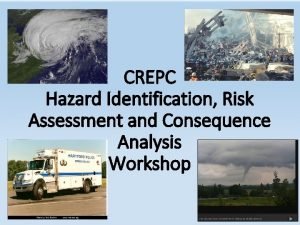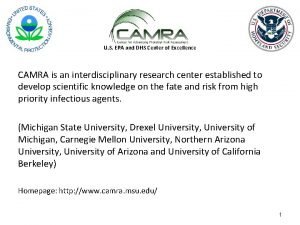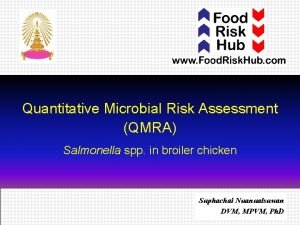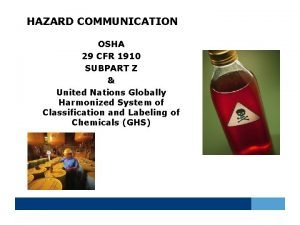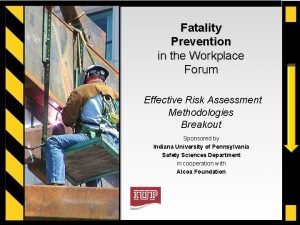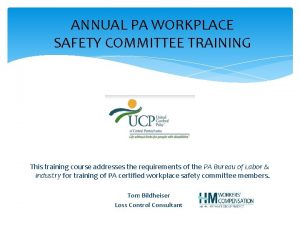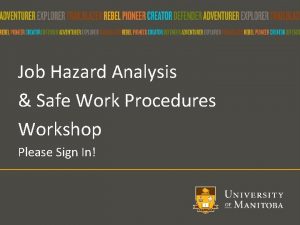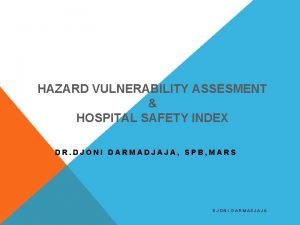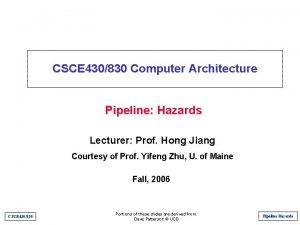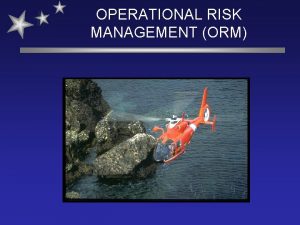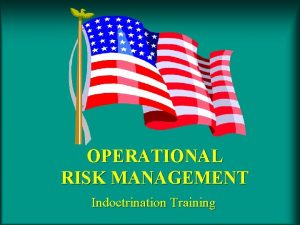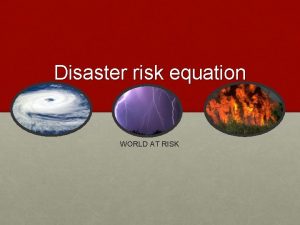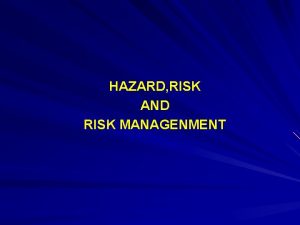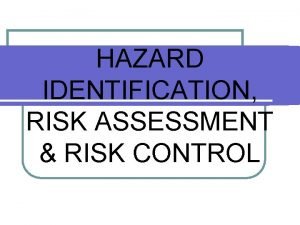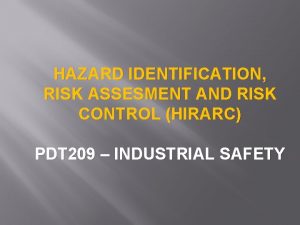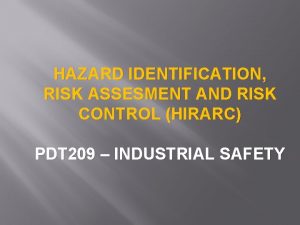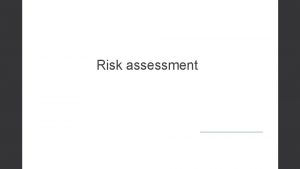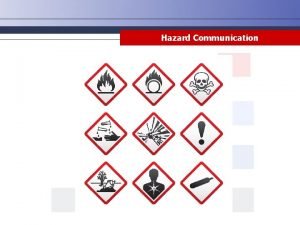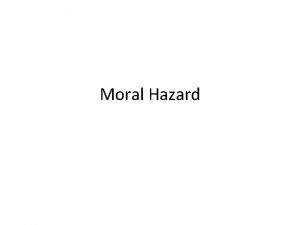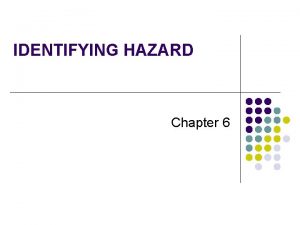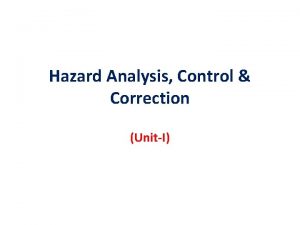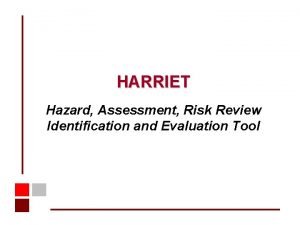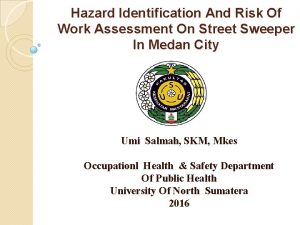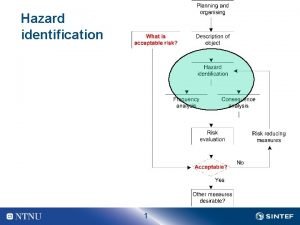HAZARD IDENTIFICATION RISK ASSESSMENT AND CONTROL IDENTIFY AT





















- Slides: 21

HAZARD IDENTIFICATION, RISK ASSESSMENT AND CONTROL

IDENTIFY AT LEAST FIVE HIDDEN HAZARDS

OSH MANAGEMENT TOOLS • • • Management Commitment OSH Policy, Plan & Procedures Consultation – Safety Committee Hazard Identification, Risk Assessment & Risk Control ( HIRAC ) Training

HAZARD IDENTIFICATION DEFINITION • Hazard – Anything that can cause harm ( physical, chemical etc ) • Risk – Likelihood ( chance/probability ) of harm actually being done

OSHA PHILOSOPHY & GUIDING PRINCIPLES “ RESPONSIBILITIES TO ENSURE SAFETY AND HEALTH AT THE WORKPLACE LIES ON THOSE WHO CREATE THE RISK AND THOSE WHO WORK WITH THE RISK ”

DIFFERENCE BETWEEN H. A. I. • Hazard – A potential danger - Oil on the floor is a hazard • Accident – An unintended happening that may result in injury, loss or damage - Slipping on the oil is an accident • Injury – The result of an accident - A sprained wrist from the fall would be an injury

HAZARD CLASSIFICATION • • • PHYSICAL CHEMICAL BIOLOGICAL ERGONOMIC PSYCHO-SOCIAL

HAZARD IDENTIFICATION METHODS • Review Legislation & Codes of practice • Accident Data • Observe • MSDS • Inspection • Job Safety Analysis etc

RISK ASSESSMENT DEFINITION “ Overall process of estimating the magnitude of risk and deciding whether or not the risk is tolerable”

TYPES OF ASSESSMENT RISK • Qualitative risk assessment is based on descriptive scale e. g workplace observation, JSA etc • Quantitative risk assessment is based on numerical values e. g. air monitoring, design calculations & other measurements

RISK ASSESSMENT PROCESS Gather information each hazard identified. • How many people are exposed? • For how long? • Existing control measures. • Previous incidents. • Osha compliance?

ASSESS THE LIKELIHOOD How likely a hazardous situation occur? • Very likely – could happen frequently • Likely – could happen ocassionally • Unlikely – could happen but only rarely • Highly unlikely – could happen but probably never will

ASSESS THE CONSEQUENCES What might be the consequences of hazardous situation? • Fatality • Major Injuries ( irreversible injury/health ) • Minor Injuries ( reversible injury - days off) • Negligible Injuries ( first aid )

QUALITATIVE RISK TABLE Rate according to how serious the risk is! Consequences Likelihood v. likely unlikely h. unlikely Fatality high medium Major In. High high medium Minor In. High medium med. Low Negli. In. Medium med. Low low

THE QUALITATIVE RISK ASSESSMENT LIKELIHOOD CONSEQUENCE Very Likely (4) Likely (3) Unlikely(2) Very Unlikely (1) Fatality (4) 16 (H) 12 (H) 8 (H) 4 (M) Major Injuries (3) 12 (H) 9 (H) 6 (M) 3 (M) Minor Injuries (2) 8 (H) 6 (M) 4 (M) 2 (L) Neg. Injuries (1) 4 (M) 3 (M) 2 (L) 1 (L) H – High Risk M – Medium Risk L – Low Risk

RATING TABLE OF HAZARDOUS ACTIVITIES HAZARD 1 Personnel Observation Physical a) Noise - machine Unlikely (2) Major Injuries (3) 6 M b) Electrical - defective V. Unlikely (1) Fatality (4) 4 M c) Heat - furnace Unlikely (2) Minor Injuries 4 M d) Fire – no system Unlikely (2) Major Injuries (3) 6 M e) Explosion - chemical V. Unlikely (1) Fatality (4) 4 M f) Unguarded machine V. Likely (4) Minor Injuries (2) 8 H g) Dust – chemical/fumes Unlikely (2) Major Injuries (3) 6 M Radiation V. Unlikely (1) Major Injuries (3) 3 M Chemical a) Vapour Unlikely (2) Minor Injuries (2) 4 M b) Dust/Particulars Unlikely (2) Major Injuries (3) 6 M V. Unlikely (1) Major Injuries (3) 3 M Unlikely (2) Minor Injuries (2) 4 M c) Fume Psychological a) Stress LIKELIHOOD CONSEQUENCES RISK RATING RISK (H/M/L) NO

RISK CONTROL Information or ideas on control measures can come from: • Codes of practice • Industry or trade associations • Specialists • MSDS • From Manufacturers and Suppliers

RISK CONTROL STRATEGIES • • • Elimination – best solution Substitution – second best Isolation Engineering Control Administrative Control Personal Protective Equipment – last line defence! Manage HIGH RISK to LOW RISK Apply - ALARP OSHA Requirement as well

RISK MANAGEMENT • Situation assessed as very likely with fatal consequences are the most serious ( HIGH RISK ) • Situation assessed as highly unlikely with negligible injuries are least serious (LOW RISK ) • Tackle anything with a HIGH rating first!

Goals of OSH Management IDENTIFY all loss exposures EVALUATE the risk in each DEVELOP a plan IMPLEMENT the plan MONITOR the system

 Hirarc definition
Hirarc definition Thira/spr
Thira/spr Market risk assessment
Market risk assessment Hazard identification card
Hazard identification card Safety hazard identification on construction projects
Safety hazard identification on construction projects Crepc
Crepc Hazard identification
Hazard identification Hazard identification
Hazard identification Hazard identification section of the sds
Hazard identification section of the sds Hazard identification
Hazard identification Chevron hazard identification wheel
Chevron hazard identification wheel Hazard identification
Hazard identification Hazard identification
Hazard identification Inherent risk vs control risk
Inherent risk vs control risk Positive identification example
Positive identification example Difference of hazard and risk
Difference of hazard and risk Example of hazard and risk
Example of hazard and risk Hospital safety index adalah
Hospital safety index adalah Structural hazards solution
Structural hazards solution Orm methodology 4 step process
Orm methodology 4 step process Causes of operational risk
Causes of operational risk Equation of disaster
Equation of disaster
